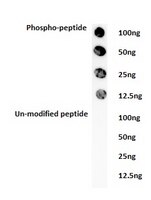Activated Cdc42-associated kinase 1 (Ack1) is required for tumor necrosis factor-related apoptosis-inducing ligand (TRAIL) receptor recruitment to lipid rafts and induction of cell death.
Linderoth, E; Pilia, G; Mahajan, NP; Ferby, I
The Journal of biological chemistry
288
32922-31
2013
Show Abstract
TNF-related apoptosis-inducing ligand (TRAIL) holds promise for treatment of cancer due to its ability to selectively kill cancer cells while sparing normal cells. Ligand-induced translocation of TRAIL receptors (TRAIL-R) 1 and 2 (also called DR4 and DR5, respectively) into lipid raft membrane microdomains is required for TRAIL-induced cell death by facilitating receptor clustering and formation of the death-inducing signaling complex, yet the underlying regulatory mechanisms remain largely unknown. We show here that the non-receptor tyrosine kinase Ack1, previously implicated in the spatiotemporal regulation of the EGF receptor, is required for TRAIL-induced cell death in multiple epithelial cell lines. TRAIL triggered a transient up-regulation of Ack1 and its recruitment to lipid rafts along with TRAIL-R1/2. siRNA-mediated depletion of Ack1 disrupted TRAIL-induced accumulation of TRAIL-R1/2 in lipid rafts and efficient recruitment of caspase-8 to the death-inducing signaling complex. Pharmacological inhibition of Ack1 did not affect TRAIL-induced cell death, indicating that Ack1 acts in a kinase-independent manner to promote TRAIL-R1/2 accumulation in lipid rafts. These findings identify Ack1 as an essential player in the spatial regulation of TRAIL-R1/2. | 24085293
 |
A study of somatolactin actions by ectopic expression in transgenic zebrafish larvae.
Guohui Wan,King Ming Chan
Journal of molecular endocrinology
45
2010
Show Abstract
Somatolactin (SL) is a fish-specific hormone that belongs to the prolactin (PRL) and GH family. Recently, two forms of SL, SL? and SL?, have been found in some species, and may have different actions and functions. To investigate the role of SL in fish growth and metabolism, we generated transgenic fish founders with ectopic expression of SL? and SL? to study the physiological functions and actions of these SLs among several marker genes. We fused the cDNAs encoding the precursor SLs in frame to a zebrafish ?-actin gene promoter to generate transgenic zebrafish lines that were coinjected with a green fluorescent protein (GFP) driven by the same promoter. The transgenic zebrafish were selected based on GFP expression and confirmed by genomic PCR, Southern blot analysis, and transgene expression. Investigations into the expression of marker genes in larvae on different pathways using real-time PCR have provided a general understanding of the actions of SLs. This study found that the overexpression of SL? and SL? in vivo significantly enhanced the transcription of IGFs, insulin, leptin, sterol regulatory element binding protein 1, and fatty acid synthase, as well as the expression level of vitellogenin and proopiomelanocortin, while causing reduced levels of catalase and glutathione S-transferase in the larvae of transgenic zebrafish. | 20801895
 |
Dasatinib inhibits site-specific tyrosine phosphorylation of androgen receptor by Ack1 and Src kinases.
Liu, Y; Karaca, M; Zhang, Z; Gioeli, D; Earp, HS; Whang, YE
Oncogene
29
3208-16
2010
Show Abstract
Activation of androgen receptor (AR) may have a role in the development of castration-resistant prostate cancer. Two intracellular tyrosine kinases, Ack1 (activated cdc42-associated kinase) and Src, phosphorylate and enhance AR activity and promote prostate xenograft tumor growth in castrated animals. However, the upstream signals that activate these kinases and lead to AR activation are incompletely characterized. In this study, we investigated AR phosphorylation in response to non-androgen ligand stimulation using phospho-specific antibodies. Treatment of LNCaP and LAPC-4 cells with epidermal growth factor (EGF), heregulin, Gas6 (ligand binding to the Mer receptor tyrosine kinase and activating Ack1 downstream), interleukin (IL)-6 or bombesin stimulated cell proliferation in the absence of androgen. Treatment of LNCaP and LAPC-4 cells with EGF, heregulin or Gas6 induced AR phosphorylation at Tyr-267, whereas IL-6 or bombesin treatment did not. AR phosphorylation at Tyr-534 was induced by treatment with EGF, IL-6 or bombesin, but not by heregulin or Gas6. Small interfering RNA-mediated knockdown of Ack1 or Src showed that Ack1 mediates heregulin- and Gas6-induced AR Tyr-267 phosphorylation, whereas Src mediates Tyr-534 phosphorylation induced by EGF, IL-6 and bombesin. Dasatinib, a Src inhibitor, blocked EGF-induced Tyr-534 phosphorylation. In addition, we showed that dasatinib also inhibited Ack1 kinase. Dasatinib inhibited heregulin-induced Ack1 kinase activity and AR Tyr-267 phosphorylation. In addition, dasatinib inhibited heregulin-induced AR-dependent reporter activity. Dasatinib also inhibited heregulin-induced expression of endogenous AR target genes. Dasatinib inhibited Ack1-dependent colony formation and prostate xenograft tumor growth in castrated mice. Interestingly, Ack1 or Src knockdown or dasatinib did not inhibit EGF-induced AR Tyr-267 phosphorylation or EGF-stimulated AR activity, suggesting the existence of an additional tyrosine kinase that phosphorylates AR at Tyr-267. These data suggest that specific tyrosine kinases phosphorylate AR at distinct sites and that dasatinib may exert antitumor activity in prostate cancer through inhibition of Ack1. | 20383201
 |
















